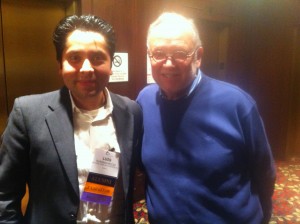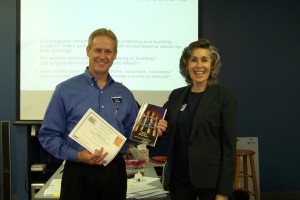Anyone who has worked within an organization knows that it is often difficult to set aside time to attend training, and when time is available, it is often gobbled up by technical or certification-required type training. However, organizations that intentionally set aside time to learn about critical topics like servant leadership or growing organizational culture often outperform their peers because Employees learn how to better serve the over-arching mission from wherever their technical or formal role may be. Top leaders, like Jack Lowe, Jr. of TDIndustries and Colleen Barrett of Southwest Airlines, know that investment in this type of learning is not a ledger liability, but an investment with the potential of exponential returns.
In my experience, however, organizations tend to encourage an inverse relationship of continuing to learn as an Employee climbs organizational rungs. True, supervisors, mid-managers, and junior executives often attend leadership-type training in near proximity to their appointment to their positions, and some remain diligent in finding opportunities to continue to grow as leaders. More often, however, the latter is the exception; even the most dedicated senior leader can easily convince themselves they do not have time, are unable to make the commitment to learning for fear of constant interruption, or, in the most arrogant of cases, have a sense they have “gotten” the concepts of leadership and the learning is only relevant for front-line members.
Organizations could very well grind to a halt if top leaders were always in training or away at a conference, yet we know that solid business results can be attained when learning matters dearly to all members, regardless of organizational position. Top leaders who state that learning is critical, yet are never seen anywhere near it, are not likely to gain authentic credibility.
How do the top leaders walk this fine line? First, I’ve seen examples of when they do something very simple yet incredibly impactful: They show up. I was quite surprised during my early tenure as an invited Customer-Member of the Southwest Airline Culture Committee to see then President Colleen Barrett sitting amongst the 200 or so members, taking part in the meeting just as any other participant. No grand opening speeches or 30 slide power points to talk about the next year’s projections from Colleen. Seemingly, however, she always made it to the microphone at least once and in a few short minutes set the tone, painted a picture of the future, and validated the hard work from everyone in the room. She wasn’t often present for the entire meeting, but the hour or so she was there mattered to the entire organization.
 I came across another shining example of “showing up” last week at the Robert K. Greenleaf Center for Servant Leadership 2013 Annual International Conference. The conference featured some headline-worthy keynote and plenary speakers. I have attended many conferences and it seems to be the norm for the “top-tier” speakers to arrive, speak with eloquence and grace, and then promptly depart to their next engagement. For this conference I was looking forward to listening to Howard Behar, former President of Starbucks and author of It's Not About The Coffee: Leadership Principles from a Life at Starbucks. The morning of Behar’s talk I chose to attend a workshop about power, and it involved some very playful and interactive experiential learning. About halfway through I was surprised to notice Howard taking part in the exercises, adding comments to the insights of participants, and talking about some of his organizational experiences. Never once did he mention his organization nor portray that he was anything other than an attendee. One of my peers, however, had recognized him the night before and thus I knew what Howard was up to. Shortly after, as Howard took the stage, it was amusing to hear many of my fellow conference attendees say, “Hey, that guy was in my breakout session!” Perhaps what they were really saying was, “He has my ear because, just like me, he’s never finished learning and growing.”
Conscious acts by top leaders can matter greatly when it comes to organizational learning, but can it be converted into systems to ensure relentless growth, regardless of positional hierarchy?
Observe TDIndustries. I recently joined a half-day “Servant Leadership in Practice” course that was facilitated by Ann McGee-Cooper and Associates, Inc. at TDIndustries. TDI has committed to perpetual growth by offering a serious of servant leadership based courses that Partners attend. While the quality of learning is top-notch, another important mechanism is at work in the courses.
I came across another shining example of “showing up” last week at the Robert K. Greenleaf Center for Servant Leadership 2013 Annual International Conference. The conference featured some headline-worthy keynote and plenary speakers. I have attended many conferences and it seems to be the norm for the “top-tier” speakers to arrive, speak with eloquence and grace, and then promptly depart to their next engagement. For this conference I was looking forward to listening to Howard Behar, former President of Starbucks and author of It's Not About The Coffee: Leadership Principles from a Life at Starbucks. The morning of Behar’s talk I chose to attend a workshop about power, and it involved some very playful and interactive experiential learning. About halfway through I was surprised to notice Howard taking part in the exercises, adding comments to the insights of participants, and talking about some of his organizational experiences. Never once did he mention his organization nor portray that he was anything other than an attendee. One of my peers, however, had recognized him the night before and thus I knew what Howard was up to. Shortly after, as Howard took the stage, it was amusing to hear many of my fellow conference attendees say, “Hey, that guy was in my breakout session!” Perhaps what they were really saying was, “He has my ear because, just like me, he’s never finished learning and growing.”
Conscious acts by top leaders can matter greatly when it comes to organizational learning, but can it be converted into systems to ensure relentless growth, regardless of positional hierarchy?
Observe TDIndustries. I recently joined a half-day “Servant Leadership in Practice” course that was facilitated by Ann McGee-Cooper and Associates, Inc. at TDIndustries. TDI has committed to perpetual growth by offering a serious of servant leadership based courses that Partners attend. While the quality of learning is top-notch, another important mechanism is at work in the courses.
 Each course has a “Class Sponsor,” a senior TD Partner who attends the entire course. The content is certainly not new to the Sponsor; he or she has succeeded because of their mastery. But they tend to realize their presence greatly influences how the entire group experiences the learning. They do not sit passively in the room. In fact, the Sponsor starts the morning with some learning expectations and purposefully tells stories of their experiences that bring relevance to the material. When they leave the room, the Sponsor reminds members that what is learned must be used when the leave the room. All of these are excellent examples of how organizational learning can be reinforced. However, there is an important underlying message, as well. The Sponsor’s presence makes it clear that the content being presented is not just a day of training provided by an outside “expert.” It is important enough for them to attend and not just send the notorious “You are going to training” memorandum. It is a statement that the Sponsor is as equally committed as the Student. Study TDIndustries’ past performance and again you will find exceptional results, and a commitment to learning is a core underlying practice.
If you are a top leader in your organization, do you “show-up” to stress the value of learning? Regardless of your place in the organization, what can you do to encourage career-long, or even life-long, learning that will not only enhance outcomes, but also the lives of everyone involved?
As always, don’t hesitate to send me your thoughts: Matthew.Kosec@gmail.com
Each course has a “Class Sponsor,” a senior TD Partner who attends the entire course. The content is certainly not new to the Sponsor; he or she has succeeded because of their mastery. But they tend to realize their presence greatly influences how the entire group experiences the learning. They do not sit passively in the room. In fact, the Sponsor starts the morning with some learning expectations and purposefully tells stories of their experiences that bring relevance to the material. When they leave the room, the Sponsor reminds members that what is learned must be used when the leave the room. All of these are excellent examples of how organizational learning can be reinforced. However, there is an important underlying message, as well. The Sponsor’s presence makes it clear that the content being presented is not just a day of training provided by an outside “expert.” It is important enough for them to attend and not just send the notorious “You are going to training” memorandum. It is a statement that the Sponsor is as equally committed as the Student. Study TDIndustries’ past performance and again you will find exceptional results, and a commitment to learning is a core underlying practice.
If you are a top leader in your organization, do you “show-up” to stress the value of learning? Regardless of your place in the organization, what can you do to encourage career-long, or even life-long, learning that will not only enhance outcomes, but also the lives of everyone involved?
As always, don’t hesitate to send me your thoughts: Matthew.Kosec@gmail.com
Comments are closed.
 I came across another shining example of “showing up” last week at the Robert K. Greenleaf Center for Servant Leadership 2013 Annual International Conference. The conference featured some headline-worthy keynote and plenary speakers. I have attended many conferences and it seems to be the norm for the “top-tier” speakers to arrive, speak with eloquence and grace, and then promptly depart to their next engagement. For this conference I was looking forward to listening to Howard Behar, former President of Starbucks and author of It's Not About The Coffee: Leadership Principles from a Life at Starbucks. The morning of Behar’s talk I chose to attend a workshop about power, and it involved some very playful and interactive experiential learning. About halfway through I was surprised to notice Howard taking part in the exercises, adding comments to the insights of participants, and talking about some of his organizational experiences. Never once did he mention his organization nor portray that he was anything other than an attendee. One of my peers, however, had recognized him the night before and thus I knew what Howard was up to. Shortly after, as Howard took the stage, it was amusing to hear many of my fellow conference attendees say, “Hey, that guy was in my breakout session!” Perhaps what they were really saying was, “He has my ear because, just like me, he’s never finished learning and growing.”
Conscious acts by top leaders can matter greatly when it comes to organizational learning, but can it be converted into systems to ensure relentless growth, regardless of positional hierarchy?
Observe TDIndustries. I recently joined a half-day “Servant Leadership in Practice” course that was facilitated by Ann McGee-Cooper and Associates, Inc. at TDIndustries. TDI has committed to perpetual growth by offering a serious of servant leadership based courses that Partners attend. While the quality of learning is top-notch, another important mechanism is at work in the courses.
I came across another shining example of “showing up” last week at the Robert K. Greenleaf Center for Servant Leadership 2013 Annual International Conference. The conference featured some headline-worthy keynote and plenary speakers. I have attended many conferences and it seems to be the norm for the “top-tier” speakers to arrive, speak with eloquence and grace, and then promptly depart to their next engagement. For this conference I was looking forward to listening to Howard Behar, former President of Starbucks and author of It's Not About The Coffee: Leadership Principles from a Life at Starbucks. The morning of Behar’s talk I chose to attend a workshop about power, and it involved some very playful and interactive experiential learning. About halfway through I was surprised to notice Howard taking part in the exercises, adding comments to the insights of participants, and talking about some of his organizational experiences. Never once did he mention his organization nor portray that he was anything other than an attendee. One of my peers, however, had recognized him the night before and thus I knew what Howard was up to. Shortly after, as Howard took the stage, it was amusing to hear many of my fellow conference attendees say, “Hey, that guy was in my breakout session!” Perhaps what they were really saying was, “He has my ear because, just like me, he’s never finished learning and growing.”
Conscious acts by top leaders can matter greatly when it comes to organizational learning, but can it be converted into systems to ensure relentless growth, regardless of positional hierarchy?
Observe TDIndustries. I recently joined a half-day “Servant Leadership in Practice” course that was facilitated by Ann McGee-Cooper and Associates, Inc. at TDIndustries. TDI has committed to perpetual growth by offering a serious of servant leadership based courses that Partners attend. While the quality of learning is top-notch, another important mechanism is at work in the courses.
 Each course has a “Class Sponsor,” a senior TD Partner who attends the entire course. The content is certainly not new to the Sponsor; he or she has succeeded because of their mastery. But they tend to realize their presence greatly influences how the entire group experiences the learning. They do not sit passively in the room. In fact, the Sponsor starts the morning with some learning expectations and purposefully tells stories of their experiences that bring relevance to the material. When they leave the room, the Sponsor reminds members that what is learned must be used when the leave the room. All of these are excellent examples of how organizational learning can be reinforced. However, there is an important underlying message, as well. The Sponsor’s presence makes it clear that the content being presented is not just a day of training provided by an outside “expert.” It is important enough for them to attend and not just send the notorious “You are going to training” memorandum. It is a statement that the Sponsor is as equally committed as the Student. Study TDIndustries’ past performance and again you will find exceptional results, and a commitment to learning is a core underlying practice.
If you are a top leader in your organization, do you “show-up” to stress the value of learning? Regardless of your place in the organization, what can you do to encourage career-long, or even life-long, learning that will not only enhance outcomes, but also the lives of everyone involved?
As always, don’t hesitate to send me your thoughts: Matthew.Kosec@gmail.com
Each course has a “Class Sponsor,” a senior TD Partner who attends the entire course. The content is certainly not new to the Sponsor; he or she has succeeded because of their mastery. But they tend to realize their presence greatly influences how the entire group experiences the learning. They do not sit passively in the room. In fact, the Sponsor starts the morning with some learning expectations and purposefully tells stories of their experiences that bring relevance to the material. When they leave the room, the Sponsor reminds members that what is learned must be used when the leave the room. All of these are excellent examples of how organizational learning can be reinforced. However, there is an important underlying message, as well. The Sponsor’s presence makes it clear that the content being presented is not just a day of training provided by an outside “expert.” It is important enough for them to attend and not just send the notorious “You are going to training” memorandum. It is a statement that the Sponsor is as equally committed as the Student. Study TDIndustries’ past performance and again you will find exceptional results, and a commitment to learning is a core underlying practice.
If you are a top leader in your organization, do you “show-up” to stress the value of learning? Regardless of your place in the organization, what can you do to encourage career-long, or even life-long, learning that will not only enhance outcomes, but also the lives of everyone involved?
As always, don’t hesitate to send me your thoughts: Matthew.Kosec@gmail.com

 “We have used a number of coaches, facilitators, and consultants through many years at Bridgeway. Sadly, too many have been considered ‘the flavor of the month,’ a fad without staying power. Ann McGee-Cooper and Associates partners with us, focusing creatively and intentionally on a small number of clients to ensure servant leadership really ‘takes.’ I've never before experienced the breadth of team leaders saying ‘this is the best thing we've done.’ From helping create a powerful tool chest of communication tools to individual executive and team member coaching to specific problem-solving, AMCA has already added significant target in the first year.”
“We have used a number of coaches, facilitators, and consultants through many years at Bridgeway. Sadly, too many have been considered ‘the flavor of the month,’ a fad without staying power. Ann McGee-Cooper and Associates partners with us, focusing creatively and intentionally on a small number of clients to ensure servant leadership really ‘takes.’ I've never before experienced the breadth of team leaders saying ‘this is the best thing we've done.’ From helping create a powerful tool chest of communication tools to individual executive and team member coaching to specific problem-solving, AMCA has already added significant target in the first year.”
